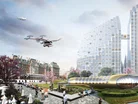Urban Transport Redefined: Future-Ready Cities in the Making

Urban transport spaces are predicted to transform in seismic fashion over the next decade.
Long associated with predictable commutes to and from work, these hubs are evolving to align with shifting behaviours, technological advancements, and rising customer expectations.
Instead of focusing on traditional work schedules, future mobility systems will reflect how people aspire to live, creating an entirely new paradigm for urban life.
Urban evolution: Shifting priorities
The changing face of cities is setting the stage for this transformation.
James Berry, Principal and Global Transport Sector Leader at Bagot-Woods, explains: “Our cities are changing. With remote working here to stay, Central Business Districts (CBDs) are moving away from a long-standing dependence on offices to become versatile, mixed-use destinations.”
This diversification is redefining urban cores, with cities integrating recreational, cultural, educational and residential elements alongside traditional office and retail precincts.
“Many cities are actively encouraging the adaptive reuse of office buildings for more relevant purposes,” James notes, highlighting that lower office vacancy rates signal a permanent shift.
As CBDs embrace these changes, so does the relationship between people and urban centres.
Despite fears of the “death of the commute,” James observes a new dynamic emerging: “An increased focus and subsequent upsurge in leisure travel to events and attractions in urban centres indicate a potential for our relationship with urban centres to become more centred on lifestyle rather than work.”
These trends will be more apparent by 2030. Initiatives like NYC’s “City of Yes,” London’s “City Plan 2040” and Melbourne’s “Plan Melbourne” envision vibrant hubs of experience and activity.
Public transport systems are expected to evolve, enhancing accessibility and community engagement.
James continues: “Public transport will evolve to be more dynamic and interconnected, fostering community engagement and making urban travel more enriching.”
Diversification: Alternative modes of transport
Urban mobility is entering an era of unprecedented innovation.
“As cities and city-goers find new rhythms, mobility is diversifying,” highlights James.
Private cars may dominate today, but emerging technologies are redefining transportation. Autonomous vehicles, air taxis and EVs are poised to reshape public transport.
“These advancements,” James adds, “are changing the nature of public transport as we know it.”
Future transport ecosystems promise to be intelligent, seamless and environmentally conscious, and James cites compelling data to support this: “With 46% of travellers planning to replace private vehicles with other modes of transport, innovations like roboshuttles and urban air taxis could tip the balance in favour of public transport.”
The drive toward sustainability is reshaping mobility choices and the transport sector, responsible for significant air pollution and greenhouse gas emissions, is under pressure to adapt.
James highlights: "Up to 5 million deaths annually could be averted if the global population became more active, according to WHO.”
This is instigating a shift towards cycling, walking and shared transport, with cities introducing policies to discourage private vehicle use and incentivise greener alternatives.
Growing expectations: Seamless spaces
Passengers today demand more than functionality—they seek personalised, reliable and accessible transport experiences. “For public and shared transport to work long-term, it must offer the same level of personalisation and safety as private transport,” James asserts.
It includes digitised services, such as Paris’s Île-de-France Mobilités app and Copenhagen’s DOT, which streamline trip planning, payments and real-time updates. Delhi Metro’s integration of WhatsApp for ticketing further supports the shift toward passenger-centric solutions.
Sydney Metro’s accessible stations exemplify the shift. James shares that “Fares can be paid using credit, debit, or Opal cards, while real-time travel information ensures seamless navigation.” Such initiatives highlight the potential for public transport to provide convenience and personalisation in equal measure.
Sydney Metro’s accessible stations exemplify the shift. James shares that fares "can be paid using credit, debit or Opal cards, while real-time travel information ensures seamless navigation.”
Such initiatives highlight the potential for public transport to provide convenience and personalisation in equal measure.
Destinations: Transforming transport spaces
Urban transport hubs are no longer mere transit points—they are becoming vibrant destinations.
James explains: “Transport buildings will merge with civic spaces, becoming destinations in their own right, where people gather, shop and connect.”
The transformation prioritises living over working, integration over isolation and personalisation over uniformity. Transport hubs are emerging as symbols of civic pride and community expression, deeply integrated into the urban fabric.
James concludes: “These factors position urban transport spaces to not only facilitate movement but enrich urban life itself.”
Explore the latest edition of EV Magazine and be part of the conversation at our global conference series, Sustainability LIVE and Manufacturing LIVE.
Discover all our upcoming events and secure your tickets today.
EV Magazine is a BizClik brand
- BYD Surpasses Tesla in Quarterly Sales Amid EV Market ShakeuMobility
- SMMT: Car Manufacturing Challenges Amid Industry PressureMobility
- Charge Gully: Bridge EV Gaps for Deprived AreasCharging & Infrastructure
- Emporia & Treehouse Simplify Home EV Charging & InstallationCharging & Infrastructure


